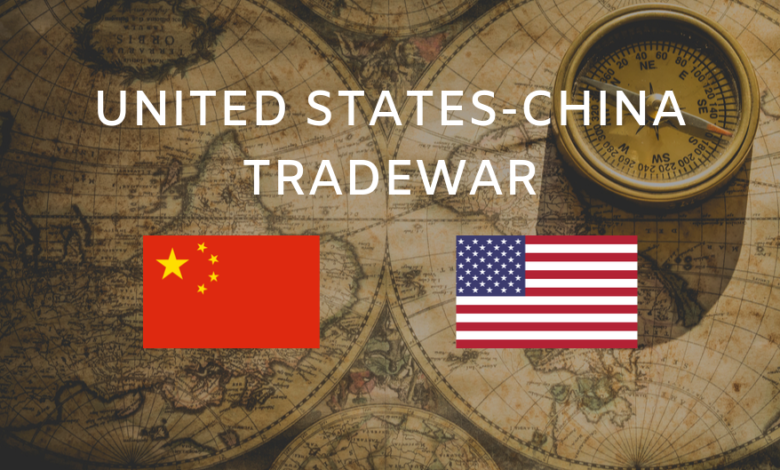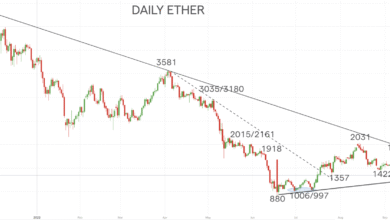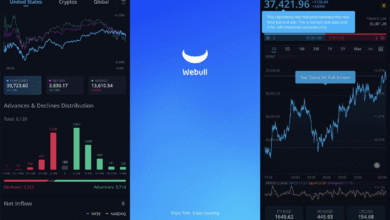U.S.-China Trade War Escalates as Beijing Raises Tariffs

The U.S.-China trade war has emerged as a pivotal issue in global economics, with escalating tensions between the world’s two largest economies significantly impacting international markets. With Beijing imposing steep tariffs in retaliation to U.S. measures initiated by President Trump, observers are concerned about the long-term economic impact of these trade disputes. Moreover, the aggressive stance taken by China, including a recent increase in tariffs to as high as 34% on U.S. imports, signals a lack of willingness to engage in constructive trade negotiations. As both nations maneuver for leverage, the specter of further U.S. tariffs looms larger, straining relationships and complicating future trade discussions. This escalating cycle of tariffs and retaliations raises critical questions about the sustainability of U.S.-China economic ties and their global ramifications.
The economic conflict between the United States and China, often referred to as the trade war, has been characterized by a series of confrontational trade policies that both nations have employed against each other. Analysts note that China’s swift implementation of counter tariffs and its refusal to engage in negotiations reflects a growing divide between these superpowers. As tensions escalate, the repercussions on both economies and the global market cannot be overstated, with significant tariffs and retaliatory measures taking center stage. The intensifying economic rivalry hints at a potential decoupling of commercial relations, which could have profound implications for international trade structures. This ongoing saga of trade disputes underscores the precarious balance of power in the global economy.
The Escalation of the U.S.-China Trade War
The risk of a prolonged U.S.-China trade war has significantly escalated in recent months. Analysts indicate that Beijing’s counter tariffs, applied in response to U.S. President Donald Trump’s aggressive trade policies, have created a volatile environment for global trade. As the two economic superpowers engage in tit-for-tat retaliatory actions, the possibility of a calamitous breakdown in negotiations seems increasingly likely. The trade tensions exemplify deeper economic and ideological rifts that could reshape international relations for years to come.
The current state of affairs points towards an intensification of tariff impositions and retaliations. China’s latest substantial levies on U.S. imports reflect a determination to match U.S. measures, indicating a shift from cautious negotiation attempts to a firmer stand against perceived U.S. bullying. This aggressive stance by Beijing not only suggests a likelihood of further tariffs but also raises concerns over a potential “decoupling” of the two economies, possibly leading to more severe long-term economic impacts globally.
China’s Retaliation and Economic Impact
China’s response to the U.S. tariffs has been characterized by a robust and strategic retaliation that aims to protect its own economic interests while sending a clear message to Washington. The 34% tariffs imposed on a range of U.S. goods signify Beijing’s commitment to safeguarding its market share. Furthermore, the curtailment of strategic exports, such as rare earth elements, highlights the stakes involved, not just for the U.S. but for the global supply chain, which heavily relies on Chinese resources.
The economic repercussions of these retaliatory measures are far-reaching. Analysts at Morgan Stanley estimate a potential slowdown in China’s economic growth attributable to the trade war, with projections indicating a stunted growth rate of up to 2 percentage points. Investing and consumer confidence within China could be adversely affected, leading to domestic deflation and slower export growth. Consequently, this cycle of tariffs risks not just affecting the two nations involved but could trigger instability in the broader global economy.
Impact on Global Trade Negotiations
The ongoing conflict between the U.S. and China has created a significant standstill in global trade negotiations. The recent abandonment of dialogue by China signifies a drastic change from previous attempts to broker peace and stability in trade relations. Economists express concern that the U.S.-China trade war has devolved into a phase where resolving issues via negotiations has become nearly impossible, pushing both countries further into isolation rather than collaboration.
As trade negotiations languish, the absence of diplomatic engagements invites uncertainty into global markets, exacerbating a market rout reminiscent of the financial crisis. The lack of mutual concessions means that companies exposed to international trade face increased operational costs due to rising tariffs, leading to potential job losses and market volatility worldwide. Ensuring future trade stability will require both nations to reconsider their strategic priorities and rethink their approaches towards fair and equitable trade practices.
The Role of Tariffs in U.S.-China Relations
Tariffs have emerged as a primary tool in the arsenal of both the U.S. and China as they engage in this high-stakes trade war. President Trump’s administration has leveraged tariffs to counter what they perceive as unfair trade practices by China, while Beijing has reciprocated with comparable tariffs aimed at U.S. exports. This escalation underscores the complexities involved in using tariffs as a bargaining chip, as increased tariffs often lead to retaliative measures rather than productive negotiations.
The tariffs imposed by both nations not only affect bilateral trade but also ripple through global supply chains, impacting industries and consumers worldwide. As countries scramble to adjust to the shifting trade landscape, many are forced to rethink their strategies for collaborating with these economic giants. Consequently, the reliance on tariffs in this trade war highlights the pressing need for finding alternative, more constructive methods of conflict resolution.
Long-term Prospects for U.S.-China Trade
Looking towards the future, the prospects for U.S.-China trade relations appear increasingly uncertain. The recent aggressive behaviors and rhetoric from both sides indicate a long-term confrontation may be on the horizon. With China’s insistence on protecting its sovereignty and economic interests against what it perceives as external pressure, and the U.S.’s commitment to countering this by any means necessary, the stage is set for a drawn-out conflict that could span years.
Market analysts are increasingly concerned that prolonged tariffs will hinder economic growth, not just in the U.S. and China but globally. Proposals for new rounds of tariffs suggest a lack of willingness to compromise, thereby diminishing the chances of a quick resolution. As both nations stake out their positions, global markets and economies may have to adapt to a new reality—a fragmented trade landscape defined by tariffs rather than mutual cooperation.
Global Market Reactions to Trade Escalation
The global markets have reacted swiftly and negatively to the unfolding escalation of the U.S.-China trade war. The significant decline in indices, such as the Hang Seng China Enterprises Index, illustrates the mounting investor anxiety over the economic implications of heightened tariffs. Investors are keenly aware that prolonged trade tensions could undermine economic growth, leading to widespread repercussions in equity markets around the world.
As uncertainties continue to permeate financial markets, companies reliant on stable trade relations are reevaluating their strategies. The downward spiral observed in key markets serves as a warning signal that instability in one of the world’s largest trade relationships inevitably breeds wider economic consequences. Consequently, businesses may seek ways to mitigate risk by diversifying supply chains or pursuing alternate markets amidst this growing uncertainty.
Responses of Chinese Leadership to Rising Tariffs
The Chinese leadership’s response to rising tariffs from the U.S. has been one of strong resistance. Statements from China’s Ministry of Foreign Affairs underline a determination to defend national interests amid increasing economic adversities. By showcasing a united front in the face of external pressures, Chinese officials signal that they are prepared to endure trade losses rather than concede during negotiations.
This resolute stance not only reflects domestic political priorities but also aims to bolster nationalistic sentiments among the populace. As the trade war drags on, it becomes crucial for Chinese leadership to manage public perception and economic stability simultaneously. Their efforts to underscore resilience in the face of external tariffs may serve to consolidate power at home while fostering a narrative of strength against foreign opposition.
Potential for Future Trade Agreements
Despite the current tensions embroiling the U.S. and China, some analysts remain cautiously optimistic about the potential for future trade agreements. The cyclical nature of trade relations suggests that while tariffs may dominate the landscape now, historical patterns indicate a capacity for negotiation and compromise. The possibility of reaching mutual agreements exists, especially when both nations face significant economic pressure due to an escalating trade war.
For any potential agreements to materialize, both parties will need to demonstrate a willingness to prioritize dialogue over retaliatory measures. As Beijing and Washington assess the economic ramifications of their actions, the desire for stability could ultimately pave the way for renewed negotiations. Creative approaches towards conflict resolution may potentially yield a resolution that de-escalates tensions and encourages collaborative trade practices moving forward.
The Importance of Economic Stability Amidst Trade Tensions
In an interconnected global economy, the significance of economic stability cannot be understated, especially amidst the tumult of the U.S.-China trade war. Amid escalating tariffs and countermeasures, markets around the world reflect heightened levels of anxiety that threaten overall economic growth. For both nations and their trading partners, maintaining stable economic conditions is crucial to safeguard against shocks and to foster a conducive environment for trade.
To mitigate the adverse effects of trade tensions, both the U.S. and China must consider policies that promote economic resilience. Strategies aimed at bolstering domestic consumption could offset negative impacts stemming from reduced trade volumes. Ultimately, the pathway to economic stability amidst trade tensions will require cooperative efforts and innovative policy solutions that look beyond short-term gains and prioritize sustainable growth.
Frequently Asked Questions
What are the main causes of the U.S.-China trade war?
The U.S.-China trade war primarily stems from ongoing disputes over tariffs and trade practices. Key issues include U.S. allegations of unfair trade practices, intellectual property theft, and a significant trade deficit with China. The implementation of U.S. tariffs, including Beijing tariffs on American goods, has escalated tensions and prompted China to retaliate with counter tariffs.
How has China retaliated against U.S. tariffs during the trade war?
China has responded to U.S. tariffs by imposing its own counter tariffs on a wide range of U.S. goods, echoing the same percentage increases as U.S. tariffs. Initially pegged at 10-15%, these tariffs were soon raised to 34%, impacting various sectors, especially agriculture and energy. Additionally, China has implemented export restrictions on critical materials and added U.S. firms to its ‘unreliable entities’ list.
What is the economic impact of the U.S.-China trade war on both nations?
The economic impact of the U.S.-China trade war has been significant for both economies. The tariffs have led to increased costs for consumers and businesses, reduced export growth from China by an estimated 1.5 to 2%, and contributed to domestic deflation. Moreover, both nations face a potential slowdown in economic growth due to escalating trade tensions and shrinking commercial ties.
Are there any ongoing trade negotiations between the U.S. and China?
Currently, trade negotiations between the U.S. and China have stalled. Following a series of heightened tariffs and aggressive posturing from Beijing, both sides have demonstrated diminished hopes for a near-term resolution. Analysts indicate that Beijing’s recent actions signal an unwillingness to engage in negotiations, making it highly unlikely for a trade deal to emerge soon.
How do U.S. tariffs affect global markets in the context of the U.S.-China trade war?
U.S. tariffs significantly affect global markets by creating uncertainty and volatility. The escalatory nature of the U.S.-China trade war has led to declines in market indices and weakened currencies, such as the offshore yuan. Businesses adjusting to tariffs face increased costs, which can ripple through supply chains and affect international trade dynamics.
What role do Beijing tariffs play in the U.S.-China trade war escalation?
Beijing tariffs are a critical element in the U.S.-China trade war, as they reciprocate U.S. tariffs and signal China’s resolve to defend its economic interests. The introduction of Beijing’s tariffs exacerbates tensions and contributes to a cycle of retaliation and increased trade barriers, making resolution more difficult and potentially leading to unmanaged economic decoupling.
| Key Point | Details |
|---|---|
| Beijing’s Response | Beijing retaliated with a 34% tariff on all U.S. goods and abandoned calls for negotiations. |
| Escalation Risks | Analysts warn of rising odds of unmanaged decoupling by 2025 due to escalating tensions. |
| Long-term Tariffs | The U.S. tariff rate on Chinese imports could reach as high as 65%, detrimental to China’s economy. |
| Negotiation Challenges | Beijing’s recent stance makes a near-term trade deal highly unlikely, according to experts. |
| Impact on Markets | The uncertainty has led to significant declines in Chinese share markets and weakening of the yuan. |
Summary
The U.S.-China trade war has escalated significantly as Beijing’s strong counter tariffs respond to U.S. actions, raising the stakes for both economies. With analysts predicting a heightened risk of unmanaged decoupling by 2025, the absence of negotiations suggests a prolonged period of financial strain. The implications of these decisions reverberate through global markets, highlighting the challenges each nation faces as they navigate this complex trade landscape.




